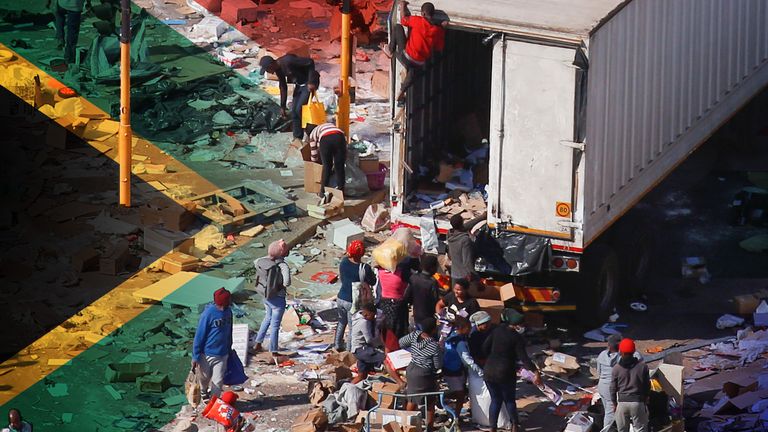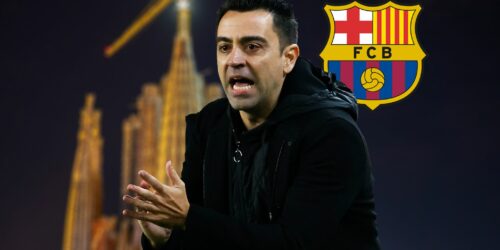After days of riots, South Africa is beginning to return to normal, but just what that will look like is still unclear. More than 200 people were killed, and hundreds were arrested—but the human, economic, and political cost of the riots is still being tallied. What’s more, the government’s confused response reveals divisions within the ruling African National Congress (ANC)—rifts which are destabilizing the country.
The trigger. Last Thursday, as former South African President Jacob Zuma spent his first night in prison, sentenced to 15 months in jail for contempt of court, fires were lit in parts of Zuma’s KwaZulu-Natal stronghold. Trucks carrying essential goods were set alight, and a national highway was blockaded in protest, which continued over the weekend and spread to the South African cities of Pietermaritzburg and Durban.
The protest shifted to looting, targeting supermarkets in Durban’s townships and small businesses in the city’s center. By Sunday, the looting had spread to downtown Johannesburg, but it was in the townships on the city’s edges where the most damage occurred. On Monday, South Africans woke up to rolling television news coverage of looters running into shopping malls, carrying groceries, clothing, and appliances out of shops.
Police watched helplessly as looters lifted whole refrigerators or walked out with television sets. By this point, few protesters mentioned Zuma’s name, and instead, it became a free for all spurred by criminal opportunism and sheer hunger.
The looters, who didn’t even bother covering their faces from police or the cameras, were largely young, Black South Africans. This is the group most adversely affected by poverty and unemployment, both of which worsened during the pandemic. In the first quarter of 2020, unemployment had reached 30.1 percent; in the same period of 2021, it had again increased to 32.4 percent. Among South Africans ages 15 to 34, it was 46.2 percent. More than a third of middle-class homes fell into poverty during the pandemic.
Then a third wave of COVID-19 infections hit during the winter, devastating the country’s economic hub around Johannesburg in particular. Low-skilled jobs were particularly affected by lockdown measures, adding to the economic burden—particularly for young Black South Africans. These were the victims of the so-called “nine wasted years” of the Zuma presidency, in which corruption saw the looting of state coffers and the hollowing out of state-owned companies, from rail to electricity, by Zuma’s cronies.
The response. A lackluster national address by South African President Cyril Ramaphosa on July 11 failed to quell the violence. Ramaphosa made broad statements like “this violence may indeed have its roots in the pronouncements and activities of individuals with a political purpose and in expressions of frustration and anger.” Instead, some fear his characterization that “some people who sought to agitate for violence and disorder along ethnic lines” only fueled more anger.
A subsequent press briefing of South Africa’s security chiefs revealed the lack of cohesion in Ramaphosa’s cabinet. Police seemed to be caught off guard despite warnings from the state spy agency. Intelligence services said they have identified individuals who coordinated and instigated the violence while police launched an ill-advised, door-to-door campaign to seize looted goods unless a receipt could be produced.
Although some, including the president, called for the military’s deployment, the defense minister seemed unwilling to implement a state of emergency. While many observers argued the military’s heavy handedness during the first phase of the COVID-19 lockdown was reason for pause, the military’s mandate was unclear on this deployment.
The discord between Ramaphosa and his defense minister, Nosiviwe Mapisa-Nqakula, became even more glaring when Ramaphosa, in a more assertive address on Friday, described the violence as an insurrection. Mapisa-Nqakula, a senior ANC member who also served as defense minister under Zuma, told parliament the military saw no signs of an insurrection or attempted coup but rather a “counterrevolution” in the form of “criminality and thuggery,” as she put it.
Hours later, Ramaphosa again repeated his claim that this was an insurrection, saying during a Nelson Mandela Day lecture it was clear the days of looting were a “deliberate, coordinated, and well-planned attack.” Mapisa-Nqakula later said that one led to the other—counterrevolution to insurrection—only further muddling the government’s position.
The result. This confusion has made it difficult to find a solution in what could be a turning point in South Africa’s fledgling democracy. In a hint of optimism, the rolling coverage of violence and looting was replaced with footage of ordinary South Africans sweeping the streets and cleaning up storefronts. In the immediate aftermath, residents in Durban and Pietermaritzburg faced food shortages while companies were beginning to count the number of jobs lost and the cost of rebuilding.
As South Africans reckoned with the looting’s aftermath, their leaders brought little comfort. It is clear the government’s strategy is decided on a day-to-day basis, with press briefings failing to communicate a singular response. This is, unfortunately, characteristic of the ANC’s inability to develop a cohesive vision to rebuild the country after apartheid and years of corruption and provide a viable future for the next generation.






